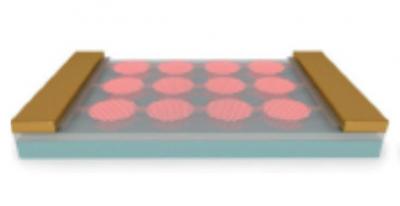Researchers from ICFO and Yale have used graphene to efficiently detect mid-infrared light at room temperature and convert it into electricity. Detecting infrared light is of major importance for current applications in spectroscopy, materials processing, chemical, bio-molecular and environmental sensing, security and industry since the mid-infrared spectral region is the range where characteristic vibrational transitions and rotational excitations of many important molecules occur.
 Schematic of the proposed device, composed of graphene-disk plasmonic resonators connected by quasi-1D graphene nanoribbons
Schematic of the proposed device, composed of graphene-disk plasmonic resonators connected by quasi-1D graphene nanoribbons
These vibrational and rotational excitations of many molecules, including hazardous and biological molecules, have frequencies that are found in the mid-infrared, which can be monitored by observing the absorption of light in this specific spectral range. However, currently available mid-infrared detectors are very inefficient, except those that can operate at cryogenic temperatures, because they incorporate superconducting elements. Thus, this low temperature limitation is a major drawback in having detectors integrated in devices for consumer products.
The researchers have proposed and experimentally demonstrated that the collective oscillations of charge carriers known as graphene plasmons â are capable of boosting the sensitivity by making use of the resonant coupling between mid-infrared light and those plasmons.
In their study, the team fabricated a device on a CVD graphene wafer composed of graphene-disk plasmonic resonators connected by quasi-1D graphene nanoribbons. They then shined mid-infrared light (12,2 ïm wavelength) onto the setup and observed the excitation and high room-temperature absorption of IR plasmons on the surface of the graphene resonators and nanoribbons. They also observed that, thanks to the graphene nanostructures, the absorption of light that was being converted into an electrical responsivity was strongly linked to the level of the plasmonic absorption, with response times enabling detection at GHz speeds.
The results of this study show graphene to be an excellent material for ultrafast conversion of light to electrical signals at room temperature, triggering the development of very small-sized detectors that could be easily integrated into high-resolution mid-infrared cameras or high density integrated infrared photonic circuits aimed for applications such as security, bioassays or air quality monitoring, among others.